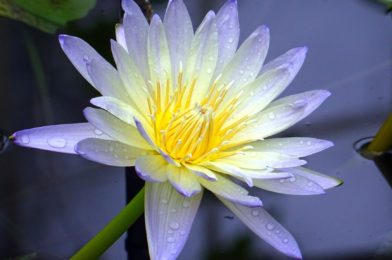Nature often surprises us with true wonders. There are the flowers that can leave anybody speechless. The seed-bearing part of a plant, consisting of reproductive organs that are typically surrounded by a brightly coloured corolla (petals) and a green calyx (sepals) is called flower. There are many fragrant and beautiful flowers on earth, but many of them are similar in size about 1inch to 5 inches in diameter. Rose is one of the most popular and loved of the beautiful flowers. Flowers are part of the most important occasions of life and have a language of their own. Flowers’ meanings and symbolization were a key element many years ago. Plants succeeded in using their flower’s deceptive development–using color and smell to attract insects and animals for pollination.
1.Rafflesia arnoldii
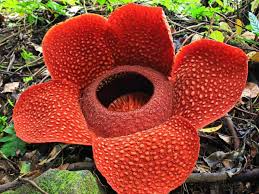
Rafflesia arnoldii is one of the world’s most endangered plant species. It has a diameter of over three feet. It is also known as Rafflesia tuanmudae or Stinking corpse lily or corpse flower and is one of the largest living organisms. The International Union for the Conservation of Nature (IUCN) classifies certain Rafflesian species, such as Rafflesia Magnifica, as “critically endangered.” This process happens once a year, when Rafflesia grows to its maximum diameter with five leathery, red spotted petals around a bowl-like center that swallows flies and insects for further sustenance. This parasitic plant is steady, not visible until it is about to bloom, with no roots, stems, twigs, or leaves. Buds arise over months to the size of the cabbage without a sign of the contaminated host plant. Corpse flower’s bloom too has a rotten corpse smell. The rafflesia feeds on a host plant to live, drinking its water and nutrients. The rafflesia’s life is tragically short. Its mouth remains open for just one week before it rots and dies. so the largest flower on Earth is on borrowed time. While the flies gain nothing from the flowers, the pollen sticks to its back as they rest on the bloom,attracted by its rotten meat scent.
When these flies pass into a female flora, the pollen is released in the flowers so they can fertilize it. Its produced fruit has thousands of seeds and is fleshy and small. Such fruits are consumed by tree shrews, which then continue to disperse the plant’s seeds. Rafflesia arnoldii is one of the three national flowers in Indonesia, the other two being the white jasmine and moon orchid. It was officially recognized as a national “rare flower”. Scientists just found one of the world’s largest flowers blooming in an Indonesian jungle. It was named Rafflesia after British colonialist Sir Stamford Raffles who spotted one in Indonesia in the early 19th Century. Rafflesia is a genus of flower with 28 known species, the second largest of which is Rafflesia kerrii, with blooms measuring 70 to 110 cm across, or over three feet. Only Rafflesia arnoldii of Sumatra exceeds its dimensions slightly, becoming the largest single flower on Earth. Rafflesia is endemic in Malaysia, Thailand, Indonesia and the Philippines.
- Titan arum
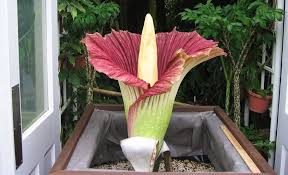
Titans normally open in the evening and the intense odor only lasts for 12 hours. The bloom will stay open (with a much lighter odor) for only 1-2 days. The plant must reach 10-15 years of age before it blooms for the first time and then blooms every 3-5 years thereafter. Titan arum also known as Amorphophallus titanum or death flower, is the flowering plant with the largest unbranched inflorescence in the world, that bloom rarely for a short period. This bud started growing in April, and we believe that it will bloom in early June. It is not among best-smelling flowers as this flower releases while it is in bloom a smell, like a rotten corpse. Fluorescence of the titan arum is not as large as the talipot palm but rather branches off, unlike talipot, which makes it a bigger flower. The plant itself reaches approximately 10 to 15 feet in height, and the leaves can be as large as 13 feet(4 m). The tallest recorded bloom of corpse flower, according to Guinness Book of World Records, was 10 feet 2.225 inches tall that also makes titan arum as the tallest flower in the world.
In the International Union for the Conservation of Nature (IUCN), the corpse flower is classified as “vulnerable” in the Red List of Threatened Plants. But, if the conditions that affect its life and reproduction do not change, the plant may become endangered. Habitat loss and devastation are the primary threats. Titan Arums are only found in the jungles of Sumatra and produce the world’s largest floral structures. Greenhouse Manager Tammy Blume and volunteer and titan enthusiast Mariah Huffman attempted pollination by hand with pollen that was collected three weeks earlier from Rotney. This pollination was successful, and Odie produced beautiful orange and red berries, which you can see below. These seeds were collected and some were used to start new plants for our collection, while others were shared with other institutions all over the country.
- Talipot palm
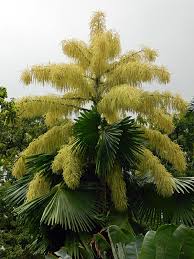
Talipot palm is one of the world’s largest palms, having origins from South India. It has a height of up to 25 m and a diameter of stems of up to 1.3 m. It is a palm fan with a diameter of up to 5 m, a petiole up to 4 m, and around 130 leaflets. The Talipot Palm has one or more million small flowers, the largest inflorescence in any plant, 6-8 m long, on a branched trunk stitched on top of a trunk. The Talipot palms are monocarpic, which means their flowers only once at the age of 30 to 80. The plant dies after fruiting. A single tree yields more than250 kg of seeds. Talipot Palm has many uses it is as useful as coconut in its native region, and Talipot fruits, which are surprisingly tasty, are known as ice apple. Their leaves are also used extensively for wall protection, for plaiting the mats and as umbrellas during rainy season. Like other palms, the central part of the stem of Corypha umbraculifera, is a rich source of starch. Palms are felled to extract this central ‘pith’ which is dried, powdered, stored and used for preparation of bread. It is a species of palm native to eastern and southern India and Sri Lanka. It is also grown in Cambodia, Myanmar, China, Thailand and the Andaman Islands. Kerala coast and the Andaman and Nicobar Islands are also home to this species. Once the seeds fall, the tree also dies.
- Neptune grass (Posidonia oceanica)
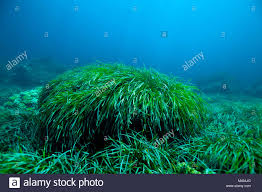
The Posidonia Oceanica, which is also named “Neptune grass,” has been sequenced by a group of scientists to be around 200,000 old seaweed covering ocean floors from Spain to Cyprus. The plant has roots, twigs, leaves, flowers, and it creates fruits known as sea olives. It forms large underwater meadows that are an important part of the ecosystem. It should not be confused with algae. It flowers in the autumn. The leaves are tape-shaped, measuring between 1 cm in width and between 30 and 120 cm in length. This aquatic plant lives in the Mediterranean Sea and in certain areas south of Australia, with similar characteristics to dry land. Among the many strengths of Neptune Grass is that it oxidizes the oceans and is also a food source formany animal species.Its appearance also shows that the water is of good quality and is well stored. Biologists often term Posidonia Oceanica as “Mediterranean’s Lungs.” Balls of fibrous material from its foliage, known as egagropili, wash up to nearby shorelines. This species is found only in the Mediterranean Sea where it is in decline, occupying an area of about 3% of the basin.
Seagrasses are a paraphyletic group of angiosperm plants, which are exclusively found in estuarine and marine environments. They belong to four families, Posidoniaceae, Zosteraceae, Cymodoceaceae, and Hydrocharitaceae. Among these, the endemic species Posidonia oceanica is predominant in the Mediterranean Sea. Posidonia meadows provide breeding and nursery grounds for various fish and other marine organisms. They influence commercial fishing and shape the coastal structure by accumulating nutrients. The meadows of the seagrass posidonia oceanica are essential for the protection of the marine environment on the Spanish Mediterranean coasts. Posidonia oceanica is a Mediterranean endemic phanerogam or flowering plant which has special characteristics which must be known at the outset in order to prevent serious environmental damage through the construction of harbour works. These characteristics include a millenary life span, a need for light and clear water, very slow growth and reproduction rate, a need for sandy beds, a shedding of leaves in Autumn and the fact that they form meadows over a very long period which stabilise the shoreline by preventing the impact of the sea.
- Puya raimondii
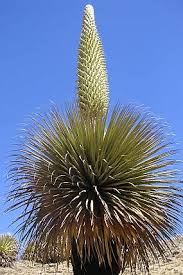
Puya raimondii is the largest bromeliad species, with a height up to 15 m and is also known as the queen of the Andes. We can find this type of plant species in Bolivian and Peruvian forests from the high Andes. The flower can reach a height of up to 30 feet (9.14 m), which contains 8-12 million seeds per plant. The Queen of the Andes in the wild have only three populations. There are thousands of species comprising the bromeliad group, but Puya raimondii has less geneticdiversity. Puya raimondii is currently on a verge of extinction because of the inability to adapt to climate changeand deforestation. The species name of raimondii commemorates the 19th-century Italian scientist Antonio Raimondi, who immigrated to Peru and made extensive botanical expeditions there. The whole plant may reach as much as 15 m (50 ft) tall.
This plant can produce between 8,000 and 20,000 flowers in a 3-month period. Its reproductive cycle lasts approximately 80 years. of the Andes (Puya raimondii) is a terrestrial bromeliad. Many bromeliads are epiphytes, growing on the surface of other plants and getting their food from the air and accumulated plant matter trapped in branch crevices. Terrestrial bromeliads have their roots in soil. There are only three populations of Queen of the Andes in the wild. Most of them have many thousands of plants, but their genetic diversity is very low. They may be unable to adapt to changes in climate. Human impacts to the populations include repeated fires to generate or maintain pasture for livestock forage.
- Common Sunflower
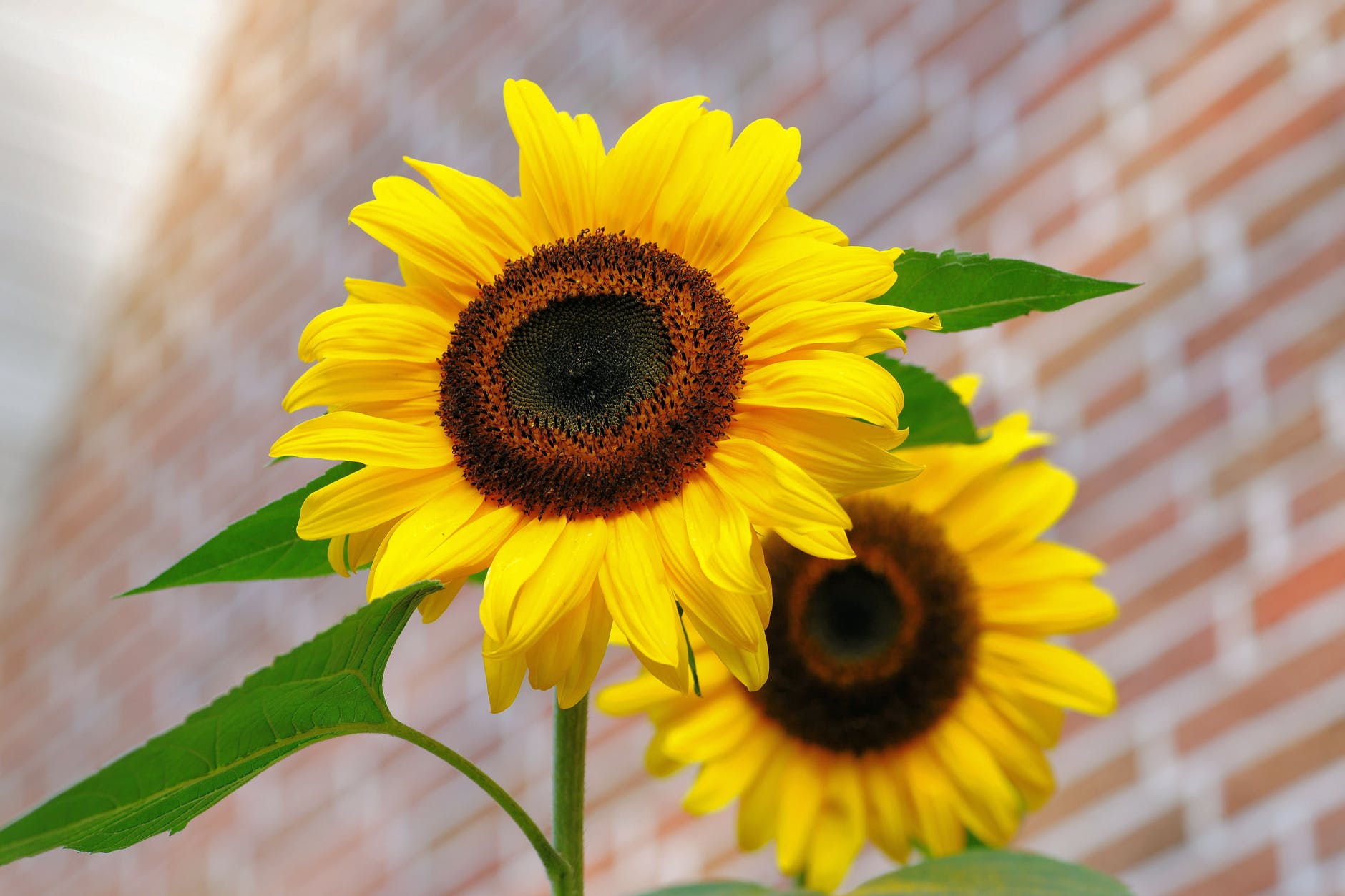
Sunflowers are extremely well-known worldwide. Sunflowers are mainly from North and South America, and some species are cultivated in farms for the spectacular sizes of their blossom and for their edible seeds. nowadays you can find them in numerous countries around the world. Sunflowers Their bright yellow color is their defining characteristic and makes them very striking. Sunflower seeds are used to make sunflower oil or can directly be eaten roasted. At least 6-8 hours of direct sunlight per day is needed for the sunflowers, the better if you try to maximize their potential for size. The excessive blooming of gigantic sunflowers is difficult to top. On towering stems, the Russian variety opens flowers up to 14 inches in diameter, 9 to 12 feet high. The disk flowers are brown, yellow, or purple, while the petallike ray flowers are yellow. The fruit is a single-seeded achene.
Oilseed varieties typically have small black achenes, while those grown for direct seed consumption, known as confection varieties, have larger black-and-white achenes that readily separate from the seed within. Farmers generally sow seeds in spring while they harvest the crop at the end of summer. If considered usability, Sunflower is the biggest flower in the world. The leaves are used as fodder, the flowers yield a yellow dye, and the seeds contain oil and are used for food. The oil is also used in soap and paints and as a lubricant. The sweet yellow oil obtained by compression of the seeds is considered equal to olive or almond oil for table use. These flowers with their gorgeous big and bright blooms have a unique and winning combination of offering some rather amazing benefits to us as well as being pretty to look at. It is a useful alternative and replacement for unhealthy margarine spreads and high fat butter for cakes and home bakes.
- Tree peony
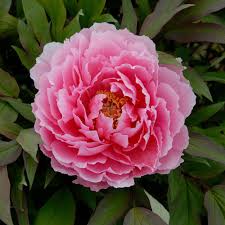
Common peony is an exquisite flower but, its bigger counterpart, the tree peony, is a very different plant. Tree peonies are woody shrubs, with no support, as some grow at 10 feet high. They have many forms, colors, and fragrances, and their flowers are much bigger and typically bloom about two weeks earlier than herby peonies. During their bloom season, which lasts for about two weeks in April and May, plants can have more than 50 blooms at one time. For gardeners we must embrace China for they provided many of our most cherished garden flowers, including the stunningly beautiful tree peony. Chinese use them as decorative ornaments and for medicinal purposes. As the season advances, the flower buds begin to swell, reaching the size of a small apple before issuing forth in late April with a flower the size of a salad plate.
Double forms are most common with the blossoms in delicate pastel shades of red, pink, white and yellow. Tree peonies can be grown in all parts of Arkansas but are less common in gardens than their herbaceous cousins. Their rarity in cultivation is because they’re difficult to propagate. Tree peonies do best in a fertile, well drained garden soil. They will grow in full sun or light shade and are easy to grow if well sited. With so many varieties of peonies available these days, selecting the right peony for your garden can be confusing. Add terms like tree peony, itoh peony and herbaceous peony, and it can seem overwhelming. The mid to late spring blossoms of tree peonies are unrivaled in size, color and fragrance.
- Hibiscus
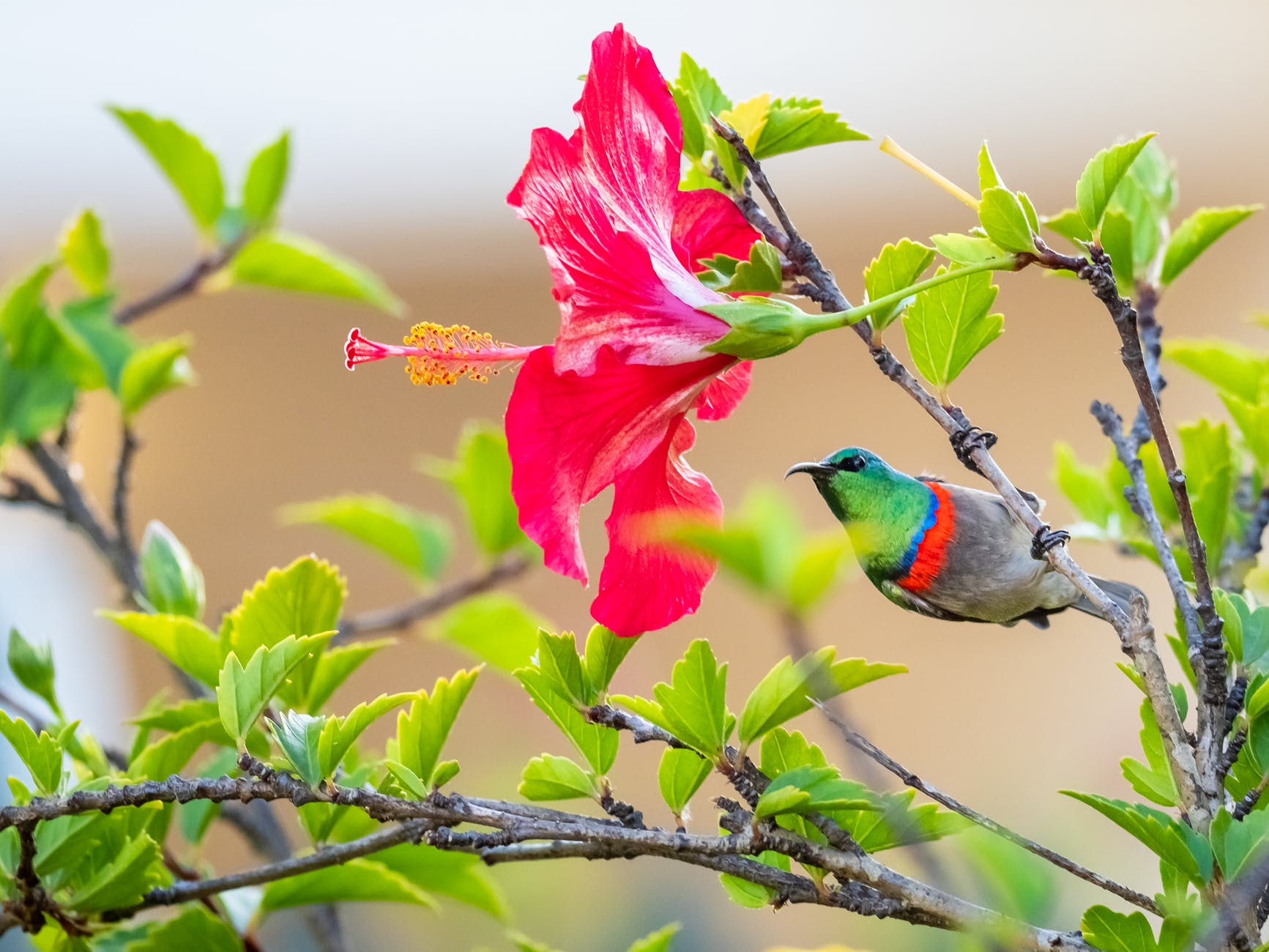
Hibiscus or Hibiscus sabdariffa is one of the world’s largest flower. The name ‘Hibiscus’ comes from hibiskos, the old Greek name for the common marsh mallow. Hibiscus develops large, trumpet-shaped flower without scent. Flower consists of five or more petals. There are over 200 species of hibiscus that can be found in the warm and tropical regions all over the world. These beautiful bright flowers surely beautify a home or garden but are also used as medicine. We can find these plants in various colors like white, yellow, orange, purple, pink, red or blue. Size wise, Hibiscus can be as wide as 8 inches in diameter. The hibiscus family is a mix of diverse plants–from annuals to perennials and shrubs–famed for their large, audacious bloom, often as big as a plate. It contains both male (stamen) and female (pistil) reproductive organs. Bees, butterflies and hummingbirds are main pollinators of hibiscus flowers.
Brightly colored flowers of hibiscus are rich source of natural dyes that are used in the food industry. Dried hibiscus is edible, and it is often a delicacy in Mexico. It can also be candied and used as a garnish, usually for desserts. Women in use dyes extracted from hibiscus flowers to dye their eyebrows and hair. The most popular beverage made of hibiscus is tea (made of dry flowers). Besides pleasant taste, tea made of hibiscus represents rich source of vitamin C. According to some medical studies, tea made of hibiscus lowers blood pressure and decreases cholesterol level. Hibiscus cannabinus is a species of hibiscus that is used in the paper industry. China and Thailand are the greatest producers of hibiscus in the world. Hibiscus is known as “shoe flower” in China because people use hibiscus to polish their shoes. The hibiscus is used as an offering to goddess Kali and Lord Ganesha in Hindu worship. Hibiscus is considered a very feminine flower.
9.Magnolia

The first flowering plant on Earth is believed by researchers to be magnolias. One of the world’s biggest flowering plants, as believed by many researchers. There are around 210 species of magnolia that differ in size, shape, color of the flower and type of habitat. Magnolia trees originate from Southeast Asia and North America, but they have been naturalized to almost all continents in the world because of their beauty. Fossils prove that they have been on Earth for around 100 million years, according to scientific research. Because magnolia is so old, the flowers have no real petals and sepals; they have petal-like tepals instead. Magnolia flowers come according to variety in various shapes, sizes, and colors. The magnolia family comprises high and fluffy trees with pink, white, red, purple, yellow blossoms. Magnolia blooms from April to June. First flowers develop seven years after planting.
Most magnolia varieties have wide bulbs measuring 6 to 8 inches in diameter.
The magnolia is eye-catching due to its soft colors and its large, lovely petals. It’s one of the most famous flowers in the world due to its beauty. It’s commonly used in decoration, bouquets, gifts, etc. Size of magnolia tree depends on the species. Smaller species are only 15 feet tall. Larger species can grow 80 feet in height. Magnolia produces cone-like brownish fruit that can reach 2 to 10 inches in length. Kidney-shaped seed can be red, orange or pink in color. Seed of magnolia is favorite food of many birds. Bark and flowers of magnolia are used in traditional Asian medicine. Leaves of magnolia are used for wrapping of food in Asia. Magnolia is resistant to most pests and diseases. Some species are prone to fungal infections. Larvae of certain insects eat different parts of magnolia tree. Wood of magnolia is used for the production of pallets and furniture. Flower contains both male and female reproductive organs. Flowers release sugary scent which attracts pollinators.
10.Lotus
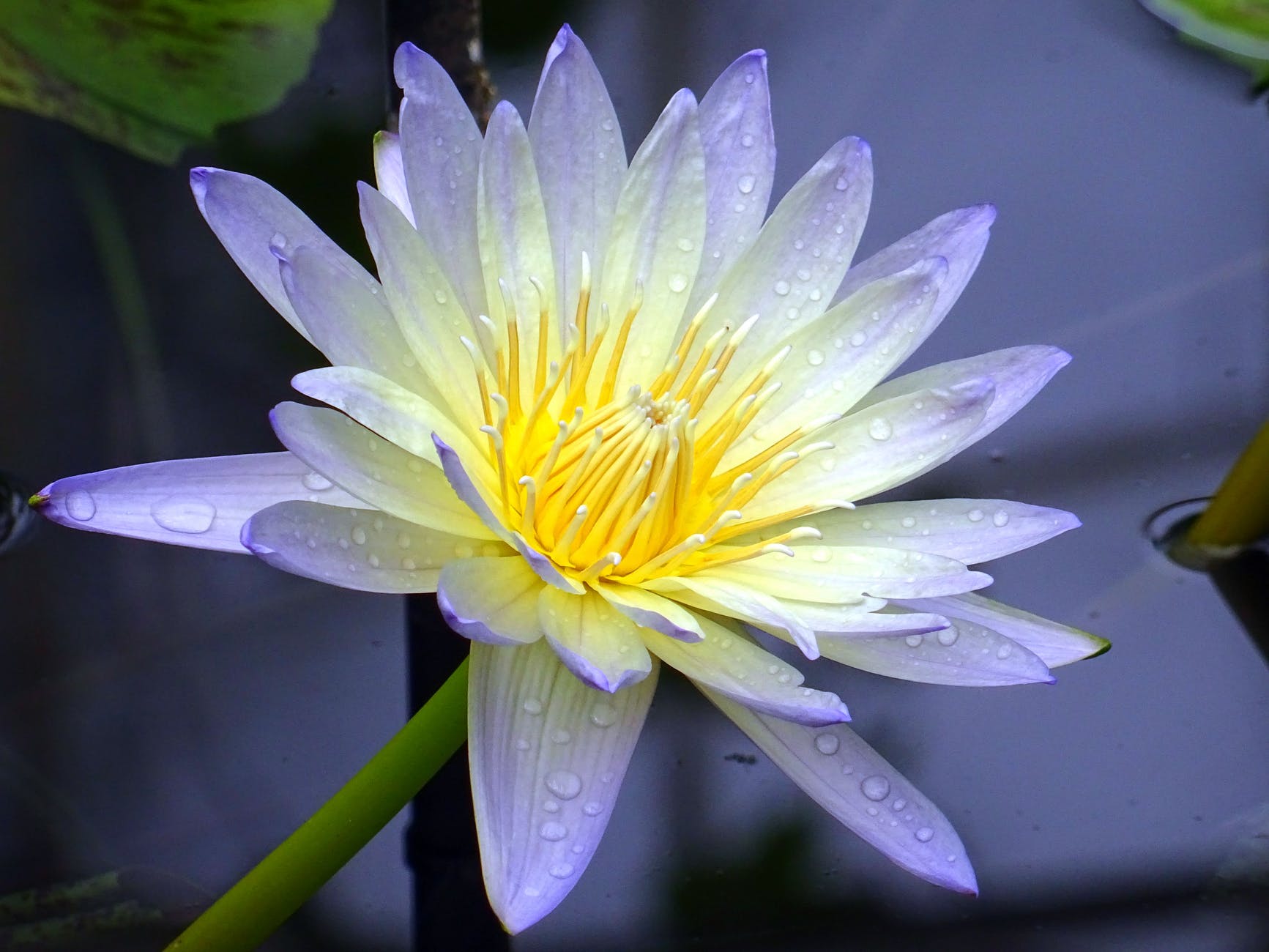
The lotus flower is also known as the “Nile flower. The Nelumbo family’s white lotus flowers and pink lotus are seen as sacredness. The lotus flower is one of the world’s most recognizable and sacred flowers. The stunning flower is a universal symbol of some of history’s most influential cultures and is the national flower of India. Lotus’s color influences its important significance. The most interesting detail about this lovely flower is the lifespan of its seeds, which can sprout after many centuries. Lotus flowers can conclude a spiritual meaning of ascent, enlightenment, or renaissance in more bright colors red, purple, and blue, white. It mostly grows in murky and shallow waters and need warm sunlight to grow, but are cold climate intolerant. This flower would not flourish in winter, consequently, as it is aquatic. With its roots in the deeper sludge, this flower only thrives in under muddy still water.
Its bloom, which is above the water surface, commonly has a diameter up to 20 centimeters when fully matured. It’s an extraordinary flower that is famous worldwide, mainly because it’s an aquatic flower. It’s India’s national flower and is symbolic in Buddhism and Hinduism for wealth, prosperity, purity and fertility. The flower species is native to Asia, and most predominantly in India and China. Flower opens in the morning and closes at night. Lotus was a symbol of sun, rebirth and creation in the ancient Egypt. Dried stamens of the lotus are used for the preparation of aromatic tea. Flower, young leaves, seeds and root are edible and often used in Asian cuisine. Older and bigger leaves are used for wrapping of food. Lotus is rich in fibers and vitamins of the B group. It is also rich source of iron and other important minerals. Lotus uses rhizomes to attach itself to the ground. This flower is known by its beautiful odor.

